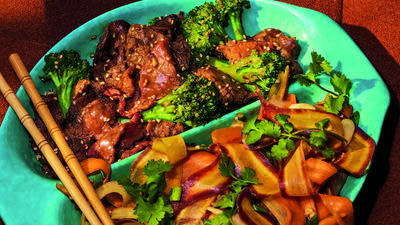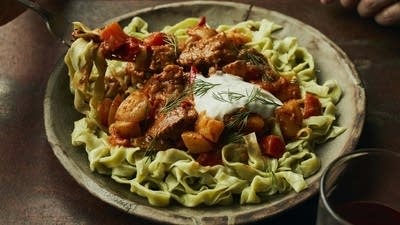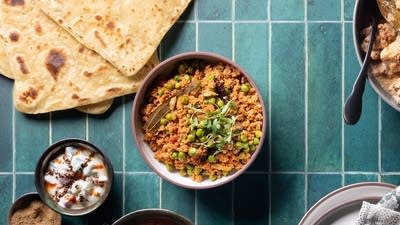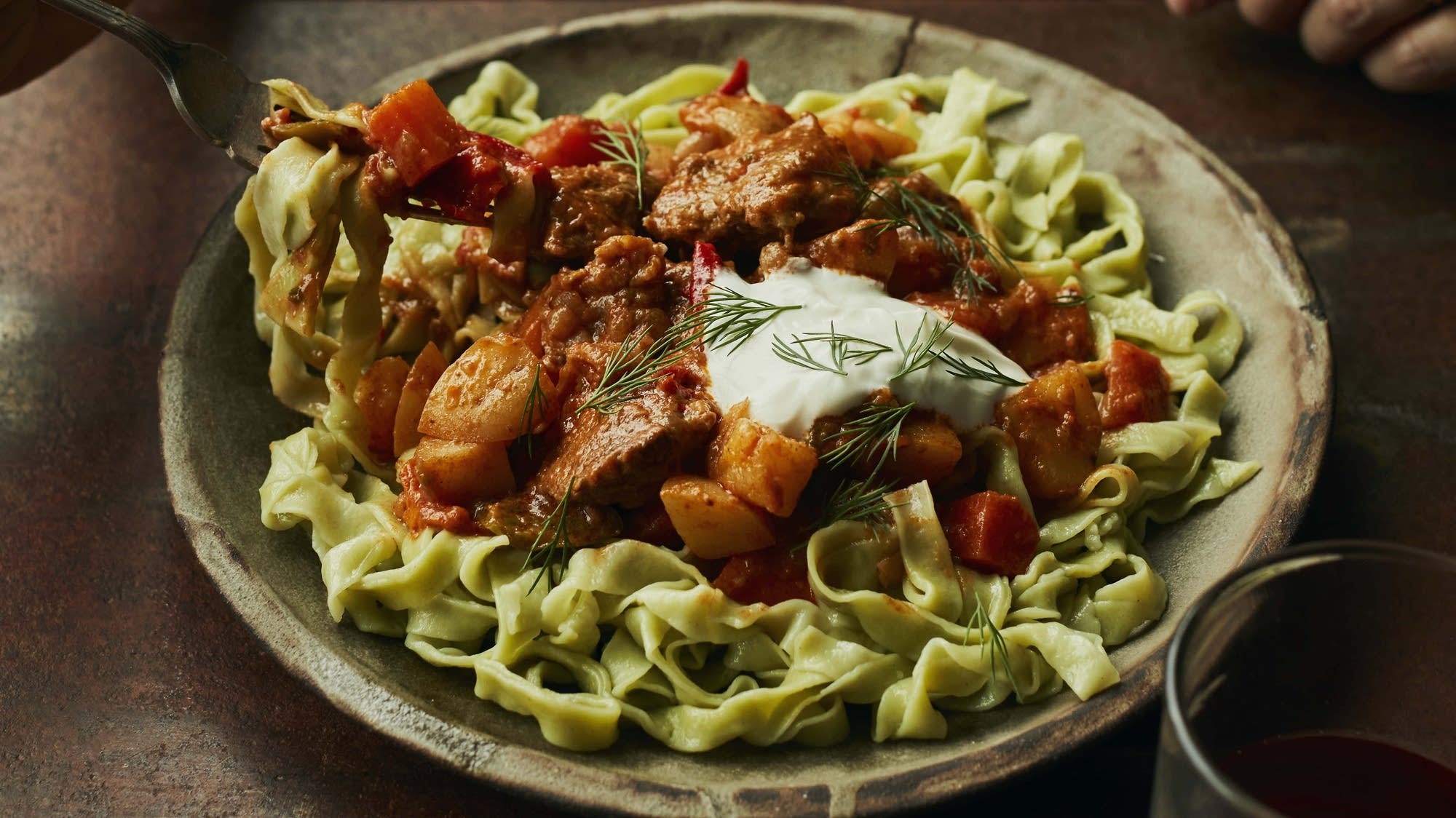
This and the Jujeh Brick Chicken Thighs are my son’s favorite dishes in this book. He is six years old, and not infrequently asks me to make him “green noodles.” I usually yield to his request, in part because my husband and I also love shivit oshi and in part because I find it so delightfully charming that Theo loves beef stew-topped, dill-infused noodles from a (relatively) remote part of Uzbekistan: Khiva, in the country’s western Khorezm region.
The noodles are actually quite easy, and the beef stew, reminiscent of a goulash, is straightforward as well. What is not easy, and what I have been unable to uncover, is the origin of this dish. Why dill? Why only in Khorezm, in Khiva? I’m stumped. Everyone I’ve asked—in and outside of Khiva—had a matter-of-fact answer that went nowhere beyond the perfunctory. “Shivit oshi? It is from Khiva. From Khorezm. It is an old dish.” That’s all I got; and that’s not much. I can tell you this, though. Nearly 3,000 miles west of Khiva, in Xian (and nowhere else in China), you can find another bright green noodle dish. The noodles in the old Chinese dynastic capital, the old terminus/starting point of the Silk Roads, are made from spinach—but they weren’t always. As local folklore would have it, during the early Tang Dynasty, courtiers and royalty were served green noodles that had been infused with leaves from pagoda trees. Plebs, eager to imitate culinary fashions of the court, began to make their own green noodles, but using spinach—which had recently been introduced to China via Nepal. Fast forward 2,100 years, and I’m slinging back a lukewarm, watery beer and slurping egg-and-tomato-topped spinach noodles on a sidewalk in Xian, two weeks after I learned to make shivit oshi in Khiva.
?
Now, I’m not saying there’s a connection between the two noodle preparations, but there definitely could be. Right? Whatever shivit oshi’s origin, it’s delicious. Plus, some say the English word “dill” comes from the Norse word dylla, which means “to soothe,” and these dill noodles most definitely soothe me, my husband, and my son. I hope they will do the same for you.
?
INGREDIENTS
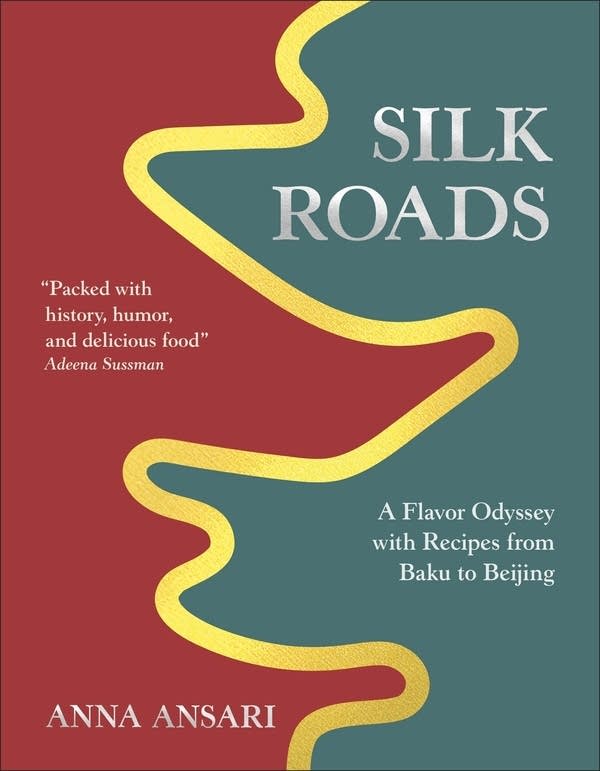 Silk Roads: A Flavor Odyssey with Recipes from Baku to Beijing
Anna Ansari
Silk Roads: A Flavor Odyssey with Recipes from Baku to Beijing
Anna Ansari
For the green noodles:
1 cup (75 g) dill, plus extra to serve
1 egg
2? cups (300 g) plain flour (use “00” flour if you’ve got it), plus extra for dusting
? tsp fine sea salt, plus extra for cooking
?
For the topping:
1 lb and 2 oz (500 g) beef shank, diced
1? tsp fine sea salt
1 tsp freshly ground
black pepper
4 tbsp ghee or olive oil
1 onion, thinly sliced into half-moons
2 garlic cloves, minced
7 oz (200 g) bell peppers (color of your choosing), cut into ? in (2 cm) pieces
1–2 spicy chilies (such as jalape?os), seeded and minced (optional, but highly recommended)
? tsp hot or sweet smoked paprika
? tsp ground cumin
2 tbsp tomato paste
1 cup (250 ml) milk
7 oz (200 g) tomatoes, roughly diced
10 oz (300 g) waxy potatoes, well washed or peeled and cut into ? in (2 cm) pieces
7 oz (200 g) carrots, peeled and cut into ? in (2 cm) pieces
plain yogurt, to serve
?
DIRECTIONS:
In a blender, blitz the dill for the noodles with a scant 1 cup (200ml) water. Once fully mixed, set your dilly water aside for at least 1 hour while you get started on the topping; this will give the dill time to infuse the water with color and flavor.
?
Pat your meat dry with paper towels and season it on all sides with 1 teaspoon of the salt and the black pepper.
?
In a large sauté pan for which you have a lid, heat 1 tablespoon of the ghee or oil over high heat. Once hot, add the meat, making sure you don’t overcrowd the pan.
?
Brown the meat on one side before turning it over and browning the other side; you’ll know it’s ready when it easily releases from the pan. For me, this process takes about 1 minute per side. Once browned, remove your beef from the pan and set it aside on a plate.
?
Reduce the heat to medium, and add the remaining 3 tablespoons of ghee or oil, along with your onion. Cook for 5–7 minutes, stirring occasionally, until softened and just starting to brown. Add the garlic, peppers, and chili(es) (if using), along with the final ? teaspoon of salt. Stir in the paprika and the cumin, then add the tomato paste. Stir again to coat and mix everything together well.
?
Return the meat to the pan, along with any juices released. Stir to combine. Deglaze the pan with the milk and leave everything to simmer for 13–15 minutes, still over medium heat, or until the milk has almost completely evaporated and the sauce has turned a dark sienna in color. Add 3 cups (750ml) water, then reduce the heat to low and leave to simmer, with the lid on but slightly ajar, for 1? hours. Set a timer so you don’t forget.
?
Meanwhile, once the dill’s infusion time is up, use a fine mesh sieve to strain the liquid into a bowl. Discard the dill and measure your water. It should be a shocking green. You will need only 1∕3 cup (100ml) of the bright green water, or about half of what you’ve got. Discard the excess dilly water (or save it and make more noodles tomorrow!).
?
Use a fork to whisk the egg and dill water together in a bowl or jug with a pouring spout.
?
Sift the flour and salt together in the bowl of a stand mixer fitted with a dough hook. Mix at a low speed, then, with the mixer still running, slowly pour in the egg and dill water mixture. Increase the mixer’s speed to medium and let it work its magic, pausing occasionally to ensure the flour from the sides of the bowl is being well incorporated, and using a spatula to scrape those sides down if it’s not. After 5–7 minutes, you should have a pliable, semihard dough. Form the dough into a ball, then leave it in its bowl, covered with a kitchen towel or plastic wrap, to rest for 1 hour.
?
When your dough has finished resting, lightly dust a baking sheet with flour and generously dust your work surface with flour. Cut your dough in four, returning three pieces to the covered bowl. Take the other piece and roll it out into a rectangle about 1∕16in (1.5mm) thick, either by hand or by using a pasta attachment for your stand mixer or a stand-alone pasta maker, if you have one in your kitchen arsenal. If rolling out by hand, rotate the dough as you work—this helps you achieve a more even thickness, and also ostensibly prevents the dough from sticking to your work surface.
?
Lightly dust the top of your thinly rolled out dough rectangle, then use your hands to roll it up lengthwise into a log, starting with the edge closest to you. Your goal is a tight-ish log; keep in mind that the tighter you roll, the more likely it is that your dough will stick to itself, and you don’t want that, but you also don’t want an overly loose dough log that won’t yield enough noodles.
?
Use a sharp knife to cut your dough log into rounds. If you prefer a wider noodle, cut your log into 1in (2.5cm) slices. If, like me, you prefer your noodles a bit thinner, cut your log into ?in (6mm) slices. However wide you cut them, unfurl the strips as you go, gently shaking them out onto the prepared baking sheet. Dust some flour on top of your unfurled noodles so that they don’t stick to one another. Repeat with the rest of the dough, reflouring your workspace before rolling out each piece.
?
At some point during this process (unless you are a super-speedy noodle-maker), your 1?-hour beef-topping timer will go off. When that happens, add the tomatoes and another 1 cup (250ml) water to your sauté pan. Stir, cover your pan once more, and leave to cook for another hour.
?
Once that hour is up, add your potatoes and carrots to the sauté pan, stir to combine, and cook for a final 30 minutes, or until your meat is falling apart and your potatoes and carrots are fork tender.
?
When your topping is ready and your noodles are, too, bring a large saucepan of well-salted water to a boil. Grab a handful of noodles, shake off any excess flour, and add them to the boiling water; repeat until all your noodles are in the pan. Cook for 2–3 minutes, then, using a slotted spoon or spider, lift them out and give them a little shimmy over the sink to shake off any excess water.
?
Serve your noodles immediately, with a portion of topping ladled over them, a dollop of yogurt, and some dill fronds on top for good measure. Don’t you love them? They’re so green, and you made them from scratch! Smile. Good on you!
Recipe reprinted from?Silk Roads: A Flavor Odyssey with Recipes from Baku to Beijing?by Anna Ansari ??2025. Published by DK. Photographs ??Laura Edwards.
When you shop using our links, we earn a small commission. It’s a great way to support public media at no extra cost to you.
Before you go...
Each week, The Splendid Table brings you stories that expand your world view, inspire you to try something new, and show how food connects us all. We rely on your generous support. For as little as $5 a month, you can have a lasting impact on The Splendid Table. And, when you donate, you’ll join a community of like-minded individuals who love good food, good conversation, and kitchen companionship. Show your love for The Splendid Table with a gift today.
Thank you for your support.
Donate today for as little as $5.00 a month. Your gift only takes a few minutes and has a lasting impact on The Splendid Table and you'll be welcomed into The Splendid Table Co-op.
